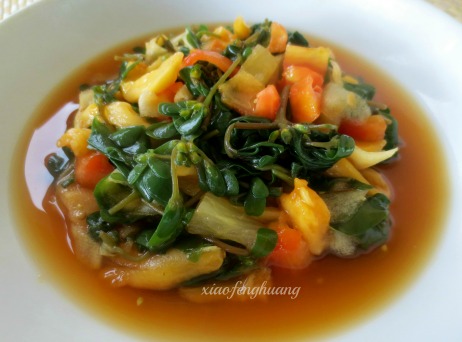Yes, they are not only edible but very nutritious as well. Chinese has been using wild portulacas as herbs and vegetables as well. It is known as Machixian(马齿苋) in Chinese. Its Hakka name is Laoshuer(老鼠耳). It tastes a bit sour and the leaves are crunchy and fleshy. Widely known as Purslane or Japanese Rose in the West, wild portulacas are sometimes mistaken for its ornamental counterpart, the portulaca grandiflora which is not edible.
Lets look at the picture below showing the blooming and inedible Portulaca grandiflora.
Look at their flowers. What a feast of colors !
Notice the needle-shaped, succulent leaves and the colorful, multi-layered flowers. Some have single-layered flowers.

A close-up shot of the flower.

“Prepare to survive in California” wrote in his blog :
“Regarded by many as a weed, common purslane (Portulaca oleracea) is also known as duckweed, fatweed, pursley, pussley and wild portulaca.
Purslane is somewhat crunchy and has a slight lemony taste. Some people liken it to watercress or spinach, and it can substitute for spinach in many recipes. Young, raw leaves and stems are tender and are good in salads and sandwiches. They can also be lightly steamed or stir-fried or simply make a wonderful fresh garden salad with it.
Purslane has high levels of soluble fiber help lower cholesterol, six times more vitamin E than spinach, is best known plant source of essential omega-3 fatty acid, alpha-linolenic acid (ALA), seven times more beta carotene than carrots, rich in vitamin C, magnesium, riboflavin, potassium and phosphorous.

In addition to ALA, other omega-3s include eicosapentaenoic (EPA) and docosahexaenoic (DHA) acids mostly found in aquatic plants and animals, especially oily fish. Nutritionists now think all forms of omega-3s need to be plentiful in our diets plants such as purslane may be part of the missing link to better nutrition. Ethnobiologists — scientists who study the relation between primitive human societies and the plants in their environment — believe that the plants humans ate long ago provided a greater proportion of nutrients than the plants we consume today. They estimate, for instance, that humans 40,000 to 10,000 years ago consumed an average of 390 milligrams per day of vitamin C from wild plants and fruits. In contrast, the average human today consumes just 88 milligrams of vitamin C per day.One cup of cooked purslane has 25 milligrams (20 percent of the recommended daily intake) of vitamin C.”
Click Table 2 , look for Germi (Iban name) for nutritional composition.
Picture above shows a bundle of wild portulacas bought from the market. Look at the picture carefully and notice its leaves are different from the ornamental portulacas. The leaves are small, oblong and fleshy which form clusters with unopened or half-opened, single layered and yellow flowers. That’s right, there are only yellow flowers, no other colors displayed by the wild portulaca flowers in Malaysia.
Purslane as Chinese herb is said to be good for hemorrhoidal bleeding. Steam for 3 minutes and blend to get thick juice for medicinal effect. Natives in Sabah and Sarawak cook them as vegetables. Hakka people in Kuching boil them for drink with rock sugar.

Picture below shows wild portulacas growing near a drain in a market. Though these are wild too but they may be contaminated by the chemicals and highly polluted water in the drain. Eat those grown in vegetable gardens or from our own gardens. To grow wild portulacas in city area is difficult. Some people tried to grow them at the backyard of their houses and they just wilted away after a few weeks. Most of this plant grow by itself in the villages and thrive well with little care.

The crunchy and fleshy leaves of wild portulacas make them the best choice for salad, salsa or mix with other vegetables in pickles before serving. Pick the young leaves only for cooking purpose. For medicinal purpose, chop the whole plant without the roots and boil.

Recipe
Wild portulacas in apple cider vinegar
Ingredients
- 500 g wild portulacas
- 1 green apple – diced
- 1 tomato – soaked in hot water, peel the skin and diced
- 1/2 cup diced small pineapple
- 1/2 tsp salt
- 4 tbs brown sugar
- 2 tbs apple cider vinegar
- 2 tbs plain water
- 1 chili – sliced
Method
- Pick the young leaves and blanch them.
- Strain and leave aside.
- Cut all the fruits.
- Mix all the ingredients in a bowl.
That is it, as simple as 1, 2, 3………OR mix the blanched purslane with cooked potatoes. Add homemade cream cheese and honey.
Another way of enjoying its crunchy leaves is by preparing salsa with the leaves.
Recipe
Fruit salsa
Ingredients
- 1 mango
- 1 green apple
- 2 tomatoes
- 200 g young purslane leaves(blanched)
- 3 limes – juice extracted
- 1 chilli – minced
- 1/4 cup of homegrown cilantro (chopped finely)
- salt to taste
Method
- Dice all the fruits.
- Mix all the ingredients.
- Serve with tortillas.
- Diced capsicums, pineapple and cucumbers can be added too for this salsa.
Simple to prepare, no fuss at all !
Copyright claim – Do not crop any pictures from malaysiavegetarianfood.com.Do not share our pictures without any watermarked signature on them.Excerpts from our articles to be credited to malaysiavegetarianfood.com.
